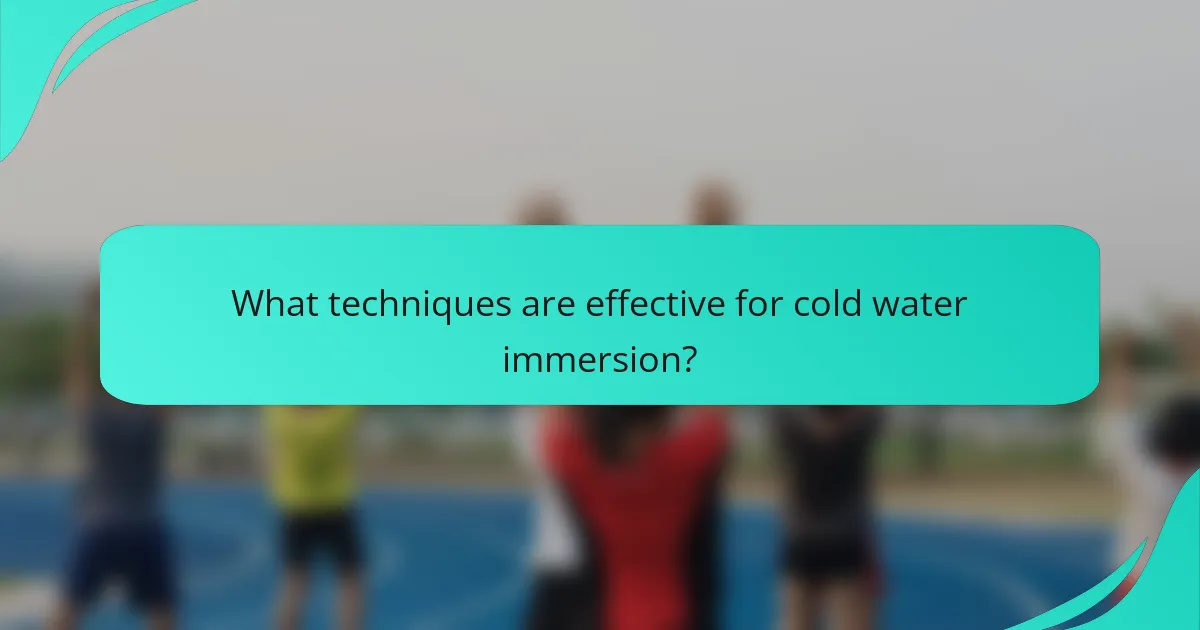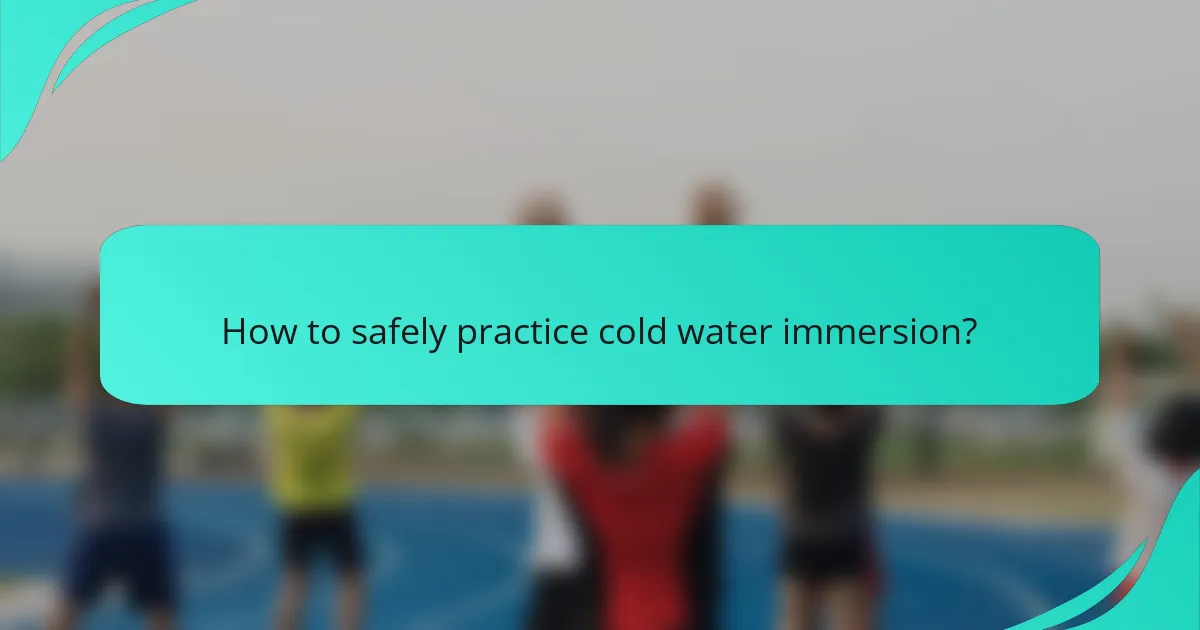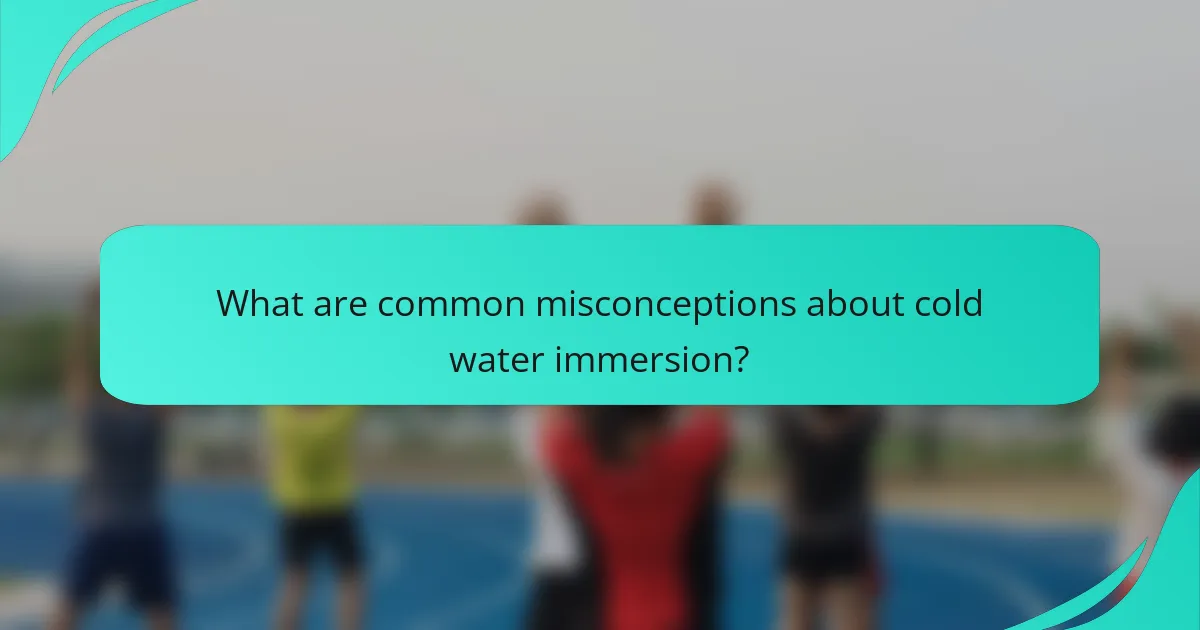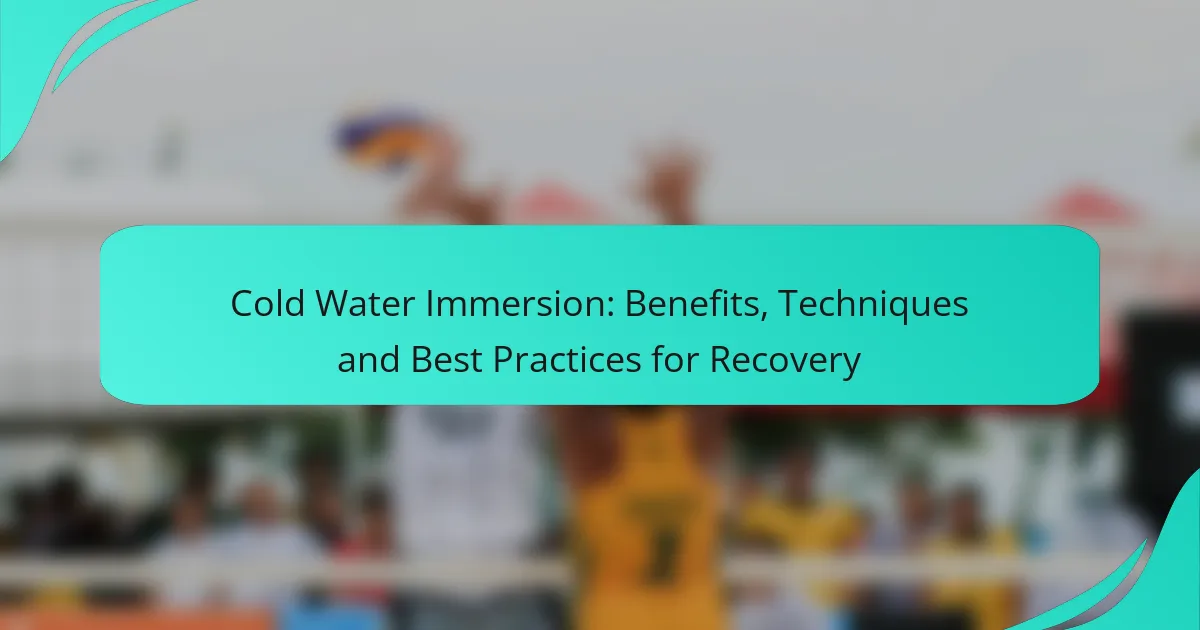Cold water immersion is a powerful recovery tool that can significantly reduce muscle soreness, enhance circulation, and speed up recovery after intense physical activity. Various techniques, such as ice baths and cold showers, cater to different preferences and needs, each offering unique advantages. To reap the benefits safely, it’s essential to gradually acclimate to lower temperatures and monitor your body’s response during each session.

What are the benefits of cold water immersion for recovery?
Cold water immersion offers several benefits for recovery, including reduced muscle soreness, improved circulation, and enhanced recovery speed. These effects can help athletes and active individuals recover more effectively after intense physical activity.
Reduced muscle soreness
Cold water immersion can significantly reduce muscle soreness following strenuous exercise. The cold temperature helps constrict blood vessels, which can decrease inflammation and numb pain receptors. This process can lead to a quicker return to normal muscle function.
To maximize this benefit, immerse yourself in cold water (around 10-15°C) for about 10-15 minutes after intense workouts. This practice is particularly effective for athletes participating in high-impact sports.
Improved circulation
Cold water immersion promotes improved circulation by causing blood vessels to constrict and then dilate upon exiting the cold. This process enhances blood flow, delivering oxygen and nutrients to the muscles more efficiently. Better circulation can aid in the removal of metabolic waste products, further supporting recovery.
Consider alternating between cold immersion and warm showers to stimulate circulation. This contrast can be particularly beneficial after long training sessions or competitions.
Enhanced recovery speed
By reducing muscle soreness and improving circulation, cold water immersion can enhance overall recovery speed. Athletes may find that they can return to training sooner and perform at higher intensities. This is crucial during competitive seasons when recovery time is limited.
For optimal results, integrate cold water immersion into your post-exercise routine, especially after high-volume training days. Consistency is key; aim for this practice multiple times a week.
Boosted immune response
Regular cold water immersion may boost the immune response, helping to fend off illnesses. Exposure to cold temperatures can stimulate the production of certain immune cells, potentially leading to a stronger defense against infections.
To harness this benefit, incorporate cold water immersion into your weekly routine, especially during peak training periods when your body is under stress.
Increased mental resilience
Cold water immersion can also enhance mental resilience by challenging the body and mind. The discomfort of cold exposure can help individuals develop better coping strategies and improve their mental toughness, which is beneficial in both sports and daily life.
Start with shorter durations in cold water and gradually increase the time as you adapt. This progressive approach can help build both physical and mental resilience over time.

What techniques are effective for cold water immersion?
Effective techniques for cold water immersion include ice baths, cold showers, cold water swimming, and contrast baths. Each method offers unique benefits and considerations for recovery, making them suitable for different preferences and situations.
Ice baths
Ice baths involve submerging the body in ice-cold water, typically around 10-15°C (50-59°F), for a duration of 10-20 minutes. This technique is popular among athletes for reducing muscle soreness and inflammation after intense workouts.
To prepare for an ice bath, fill a tub with cold water and add ice until the desired temperature is reached. Ensure you have a timer to monitor your immersion time, and consider wearing a swimsuit to protect your skin from extreme cold.
Cold showers
Cold showers are a more accessible form of cold water immersion, where individuals gradually lower the water temperature to around 15-20°C (59-68°F) and stand under the spray for several minutes. This method can invigorate the body and improve circulation.
Start with warm water and slowly decrease the temperature. Aim for a duration of 3-5 minutes, and focus on breathing deeply to help your body adapt to the cold. Cold showers can be easily integrated into daily routines.
Cold water swimming
Cold water swimming involves swimming in natural bodies of water, such as lakes or oceans, typically below 15°C (59°F). This technique not only provides physical benefits but also enhances mental resilience and mood.
Before swimming, acclimate your body to cold temperatures gradually. Always swim with a buddy for safety, and consider wearing a wetsuit if the water is particularly cold. Limit your time in the water to avoid hypothermia, especially for beginners.
Contrast baths
Contrast baths alternate between hot and cold water immersion, usually in cycles of 1-3 minutes in each temperature. This technique promotes blood flow and can aid in recovery by flushing out toxins and reducing muscle stiffness.
To perform contrast baths, prepare two containers: one with hot water (around 37-40°C or 98-104°F) and the other with cold water (10-15°C or 50-59°F). Repeat the cycles for 15-20 minutes, starting and ending with cold water for optimal benefits.

How to safely practice cold water immersion?
To safely practice cold water immersion, start with gradual exposure to lower temperatures, monitor your body’s response, and limit the duration of each session. These steps help minimize risks while maximizing the recovery benefits of cold water therapy.
Start with gradual exposure
Begin your cold water immersion journey by gradually acclimating your body to colder temperatures. Start with cool water, around 15-20°C (59-68°F), for short periods, then slowly decrease the temperature and increase the duration as your body adjusts. This approach helps prevent shock and allows your body to adapt effectively.
For example, you might start with 1-2 minutes in cool water, then progress to 5-10 minutes in colder water over several sessions. Listen to your body and increase exposure only when you feel comfortable.
Monitor body temperature
Keeping track of your body temperature during cold water immersion is crucial for safety. Use a waterproof thermometer to ensure your core temperature does not drop too low, as hypothermia can occur if your body temperature falls below 35°C (95°F). Regularly check in with how you feel, looking for signs of excessive coldness or discomfort.
A good practice is to have a buddy system in place, where someone can monitor your condition and assist if needed. If you start to feel excessively cold, it’s essential to exit the water immediately.
Limit immersion time
Limiting the time spent in cold water is vital for safety and effectiveness. Generally, aim for immersion sessions of no longer than 10-15 minutes, especially in water below 10°C (50°F). Shorter sessions can still provide benefits without the risks associated with prolonged exposure.
Consider setting a timer to avoid losing track of time while immersed. If you’re new to cold water immersion, start with shorter durations and gradually increase as you become more accustomed to the experience.
Consult a healthcare professional
Before starting cold water immersion, it’s wise to consult a healthcare professional, especially if you have pre-existing health conditions. Conditions such as cardiovascular issues, respiratory problems, or cold sensitivity may require special considerations or precautions.
A healthcare provider can help determine if cold water immersion is suitable for you and offer personalized recommendations based on your health status. This step ensures that you can safely enjoy the recovery benefits without unnecessary risks.

What are the best practices for cold water immersion?
The best practices for cold water immersion focus on optimizing the experience for recovery and performance enhancement. Key considerations include water temperature, timing after exercise, frequency of sessions, and hydration levels.
Optimal water temperature
The ideal water temperature for cold water immersion typically ranges from 10°C to 15°C (50°F to 59°F). This range is effective for reducing muscle soreness and inflammation while minimizing the risk of hypothermia. Temperatures below this range can lead to discomfort and potential adverse effects.
When preparing for a session, consider using a thermometer to ensure the water is within the optimal range. Adjust the temperature based on personal tolerance and the specific recovery goals.
Timing after exercise
Cold water immersion should ideally occur within 30 minutes to two hours after exercise for maximum effectiveness. This timing helps to reduce muscle soreness and speed up recovery. Waiting too long may diminish the benefits.
For athletes, incorporating cold water immersion into a post-workout routine can enhance recovery. However, it’s essential to balance this with other recovery methods, such as active recovery or stretching.
Frequency of sessions
For optimal recovery, aim for cold water immersion sessions two to three times per week. This frequency allows for adequate recovery without overexposure to cold temperatures, which can lead to negative effects like decreased muscle performance.
Adjust the frequency based on training intensity and individual recovery needs. Some athletes may benefit from more frequent sessions during intense training periods, while others may find less frequent immersion sufficient.
Hydration considerations
Staying hydrated is crucial when engaging in cold water immersion. Cold exposure can lead to increased fluid loss through respiration and skin, so it’s important to drink water before and after sessions. Aim for at least 500 ml (about 17 oz) of water to maintain hydration levels.
Monitor your body’s hydration status by checking urine color; pale yellow indicates proper hydration, while darker shades suggest a need for more fluids. Avoid alcohol and caffeine before immersion, as they can contribute to dehydration.

What are common misconceptions about cold water immersion?
Many people believe that cold water immersion is only beneficial for athletes or that it can lead to hypothermia quickly. In reality, cold water immersion can be advantageous for various individuals and can be safely practiced with proper techniques and precautions.
Cold water immersion is only for athletes
A common misconception is that only athletes benefit from cold water immersion. While athletes often use this technique for recovery, anyone can experience advantages, such as reduced muscle soreness and improved mood. Regular individuals can incorporate cold water immersion into their wellness routines to enhance recovery after workouts or long days.
It leads to hypothermia quickly
Many fear that cold water immersion will cause hypothermia almost immediately. However, when done correctly, such as limiting exposure time to a few minutes and using water temperatures between 10°C to 15°C, the risk is minimal. It’s essential to listen to your body and exit the water if you start feeling excessively cold.
Cold water immersion is painful and harmful
Some believe that cold water immersion is an excruciating experience that can cause harm. While the initial shock can be uncomfortable, most people adapt quickly and find it invigorating. Gradual exposure, starting with shorter durations, can help ease the transition and reduce discomfort.
It’s ineffective for recovery
Another misconception is that cold water immersion does not aid in recovery. Research indicates that it can reduce inflammation and muscle soreness, making it a valuable tool for recovery. Incorporating cold water immersion into a post-exercise routine can enhance overall recovery effectiveness.
